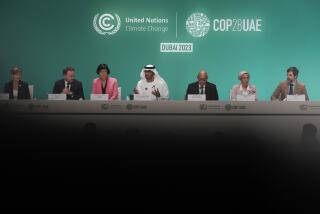Market Focus : No Boom Seen From OPEC’s New Bucks : Remember the fluctuations in the world financial markets after the oil crises in the 1970s? Experts don’t think they will happen again. But all bets may be off if war breaks out.
- Share via
WASHINGTON — Mideast analyst William B. Quandt still remembers the first time he visited Saudi Arabia. “It was 1969,” he says. “I got off the plane in Jidda, and there was this tiny, sleepy air terminal. And I just walked across the street to the one hotel in town.”
That was Saudi Arabia before the oil-price boom of the early 1970s--a vast wasteland of ancient trading posts, dirt roads and small villages, interspersed with odd-shaped, metallic oil-drilling rigs. Many other major oil-producing countries were just as desolate.
Then came the petrodollars.
The quadrupling of prices by the 13 members of the Organization of Petroleum Exporting Countries (OPEC) cartel during the first oil shock of 1973-1974--and a subsequent global price increase in 1979--brought windfall revenues that eventually bloated the coffers of Arab oil producers by $1.3 trillion. And those countries haven’t been the same since.
In little more than a decade, the once relatively impoverished Saudis, Kuwaitis and other Persian Gulf sheikdoms superimposed the industrial and financial infrastructures of up-to-date, 20th-Century nations over the framework of what are still largely traditional desert societies. They built whole cities out of the ancient trading posts, replaced the dirt roads with superhighways, erected huge petrochemical complexes, bought shopping centers and resorts in the United States and gambled with abandon--occasionally losing as much as a million dollars a night--in London’s casinos.
“Anything money could buy, they bought,” says Quandt, a National Security Council staffer during the Jimmy Carter Administration who is now at the Brookings Institution here.
This time, however, things will be different. Don’t expect a big, petrodollar-fueled real estate boom in Los Angeles, stories about another Kuwaiti-owned resort in the Carolinas, or a surfeit of Arab sheiks at Lake Tahoe. Unless the prognosticators are missing something, or an all-out war in the Middle East throws world trade into chaos, the increased petrodollar flow is likely to be far smaller--and much less disruptive to global financial markets than those that contributed so mightily to the dislocations that arose in the 1970s.
“The elements are quite different today compared with the oil shocks of the 1970s,” says Alan J. Stoga, international economic analyst at Kissinger Associates, the New York consulting firm run by former Secretary of State Henry A. Kissinger.
Among the reasons:
* The probable oil-price increase this time is considerably smaller, proportionally, than the price rises of 1973 and 1979, and therefore is expected to divert relatively less of the world’s total cash flow to the Arabs. In both previous run-ups, the major Western industrial nations had to transfer roughly 2% of their income suddenly to OPEC’s coffers as oil prices jumped from about $3 a barrel to $13 in 1973-74, and then to a peak of about $32 a barrel after 1979. By contrast today, even if oil prices rose from their pre-crisis level of about $18 a barrel to $30 a barrel and stayed there for a year, the extra $90-billion tab would cost the economically advanced countries only about 0.6% of their total income.
“If things don’t erupt in the gulf, the magnitudes are not going to be anywhere near as large as in the 1970s,” says C. Fred Bergsten, director of the Institute for International Economics, a Washington think tank. “And the benefits will be much more widely spread around, as opposed to just going mostly into what we called the ‘oil sinks’ in the gulf.”
* The major industrial countries that are the biggest oil users are far better able to cope with price hikes than they were in the 1970s. Although there’s still plenty of room for increased conservation, the industrial nations are using energy far more efficiently now than they did back then. Even a leap to $50 a barrel--something that probably would occur only if a war put a number of Middle East oil fields out of operation for a long time--would end up transferring no more than 1% of their income to oil producers this time.
* Inflation isn’t as virulent as it was in the 1970s, and therefore is less likely to exacerbate the latest oil price hike. Also, central banks around the world are unlikely to repeat the mistake they made in the 1970s, when they initially eased credit conditions, helping to fuel inflation further.
* Although it hasn’t been widely publicized, many of the major oil-producing countries are broke, or at least heavily in debt. That means any additional oil revenues are likely to go directly into rebuilding their economies. Even the wealthiest gulf producers now need all the dollars they can get in order to import the required parts and technology they must have to maintain the expensive industrial infrastructures they built during the earlier booms. That makes them unlikely to gamble away any new windfall or to invest it willy-nilly in foreign ventures.
The outlook contrasts sharply with the experience of the 1970s and early 1980s, when the two oil price shocks of 1973-74 and 1979-80 made the petrodollar king.
The 13 OPEC members collectively gained nearly $2 trillion in added oil revenues in just a dozen years, and for a time had more than $400 billion of it invested abroad. Besides Saudi Arabia, the OPEC cartel includes Iran, Iraq, Kuwait, the United Arab Emirates, Qatar, Libya, Algeria, Nigeria, Gabon, Ecuador, Venezuela and Indonesia.
Compounded by major errors in judgment by government policy makers and international bankers, the twin oil shocks of the 1970s wreaked long-lasting economic havoc in rich and poor countries alike.
The sudden transfer of so much wealth from hundreds of millions of consumers around the globe to a comparative handful of oil producers in such places as the Persian Gulf, Texas, North Africa and a few other geological oases turned world financial markets upside down.
Since many of the newly rich oil producers literally couldn’t spend the petrodollars as fast as they were coming in, they had to park the money in banks in the West. The bankers, in turn, showered billions upon billions on Latin America, Eastern Europe and elsewhere. The money never will be recovered in full, but at least it helped pay the oil bills.
After the first oil price hike, Britain and Italy were hit so hard they both had to go hat-in-hand to the International Monetary Fund for help. Latin America was the new frontier of global banking in the 1970s, but its bubble burst when Mexico and nearly all the other Latin debtors defaulted on their payments in the early 1980s.
Although the import costs of the oil-producing countries--and inflation generally--have continued to rise during the 1980s, oil prices had stagnated until the Iraqi invasion of Kuwait. As a result, the petrodollars that the oil-producers receive today don’t buy as much as they used to.
In 1980, OPEC had a surplus of $100.4 billion in its balance of international payments--the transfer of cash between cartel members and their trading partners. By 1980, it had turned into a $19-billion deficit. And it has been in the red nearly every year since.
In part, it was a cash shortage that inspired Iraqi President Saddam Hussein to attack his tiny neighbor; he wanted to raid Kuwait’s wealth. Before 1980, “Iraq had $33 billion in reserves,” said David T. Mizrahi, editor and publisher of MidEast Report in New York. “But they spent it all and much more on the war with Iran.”
For all the differences, there are also some unsettling similarities between the present situation and the 1970s. A lot of the oil money of the ‘70s went into weapons and military forces in the Persian Gulf and elsewhere, for example. That probably won’t change.
“Saddam’s invasion, no matter what the outcome, suggests that others will want to spend even more on their military,” says Daniel Yergin, head of Cambridge Energy Research Associates and author of “The Prize,” a history of oil that is due to be published soon.
“But in general, unless all-out war breaks out and everything falls apart, this is not going to be anything on the scale we saw in 1973 or 1979,” Yergin adds. “Remember what Marx said about history repeating itself? The first sequel is a tragedy, the second time it’s a farce.”
To be sure, a third oil shock would not be painless. A further sharp run-up in prices could well trigger at least a mild recession in the United States. Perhaps worst of all, higher oil prices would widen the huge gap between the haves and the have-nots of the world.
Latin American nations, particularly major oil importers such as Brazil, will be hit hard because they won’t be able to borrow--as they did in the 1970s--to make up for the trade losses they would suffer. Poor countries in Africa--such as Tanzania, which would have to fork over an extra 2.6% of its low national income--can ill afford larger oil bills.
The biggest losers, though, are likely to be Eastern Europe’s emerging democracies. For years, Poland, Czechoslovakia and other former Soviet-Bloc countries have received subsidized oil from the Soviet Union. But that is about to change. Their oil bills were already set to rise by about $6 billion next year, even at previous price levels. The recent price hike, if continued, could double that figure, forcing Poland and Czechoslovakia, for example, to commit from 35% to 75% of their hard-currency earnings just to pay for oil.
“Eastern Europe was given breathing space during past oil shocks that they may not have in 1990-91,” says Horst Schulmann, director of the Institute of International Finance, which represents large global banks. “They are going to require special attention from the international lending institutions if we want to keep them moving on the path toward the West.”
More to Read
Inside the business of entertainment
The Wide Shot brings you news, analysis and insights on everything from streaming wars to production — and what it all means for the future.
You may occasionally receive promotional content from the Los Angeles Times.










